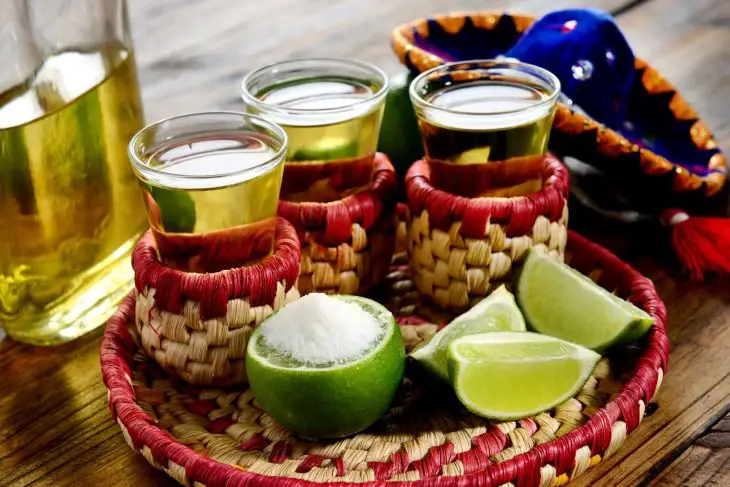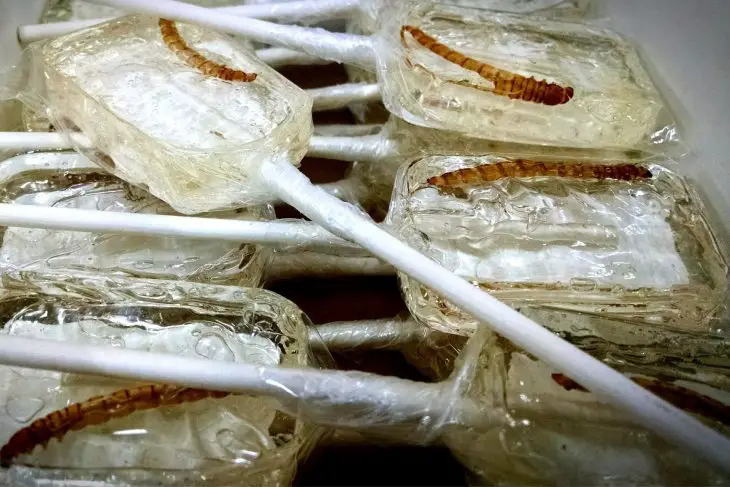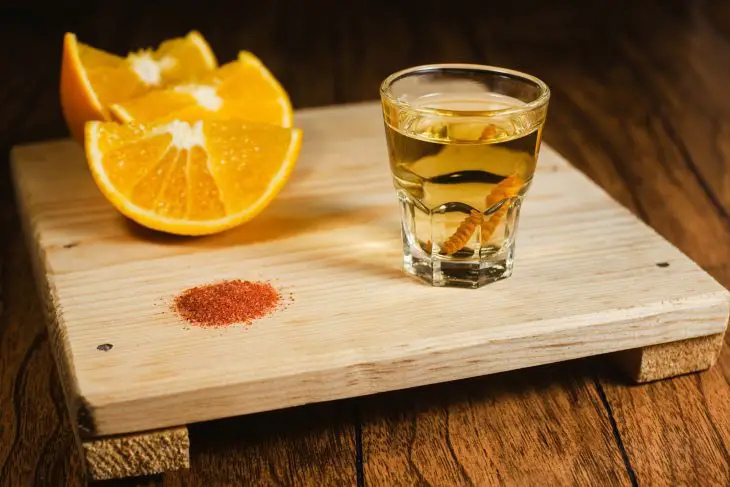Hey there! This site is reader-supported and we earn commissions if you purchase products from retailers after clicking on a link from our site.
Ah, the legendary pickled worm inside the bottle of tequila. You might want to call it the alcoholic version of the Loch Ness monster, because you’ve probably wondered once or twice if it’s just a myth. Though there’s a lot of hype surrounding tequila worms, you might have thought recently, “Wow, there’s not one bottle of tequila in this store with a worm in it! What’s up?”
Turns out, you’ve been misled. Yes, tequila worms are real. And yes, you can still find them in bottles. There are a couple of things you need to know, though.
Without further ado, here are all your questions about that little worm inside the bottle of tequila answered.
Table of Contents
- Is it Tequila or Mezcal?
- How Tequila Differs From Mezcal
- What is a Tequila Worm?
- Four Things To Know About The Mezcal Worm
- Significance of the Worm & Why It’s Used
- How to Eat The Tequila Worm
- Brands That Put Worms In Mezcal
- Final Thoughts
- Frequently Asked Questions
Is it Tequila or Mezcal?
If you’ve come all this way looking for brands of tequila with worm in it, you’re going to be slightly disappointed. There never has been any brands of tequila with a critter at the bottom. It’s a misconception. The Mexican spirit that does have a worm in the bottle is called Mezcal. Yes, both tequila and mezcal are similar, so it’s easy to see how the mistake can be made—but there is no worm in tequila.

How Tequila Differs From Mezcal
Tequila and mezcal both originate from Mexico and are made from agave, a form of succulent that grows in the Mexican desert. Both are widely popular throughout the world, but they aren’t the same thing.
Here are some key differences:
- Tequila is made with rigid standards. For starters, tequila can only be produced from blue agave, while mezcal can be made from 28 varieties of agave.
- Mezcal is traditionally from Oaxaca, Guerrero, and Michoacan. Tequila comes from the Jalisco region.
- Tequila can either be made in small batches or mass-produced, whereas mezcal is made on a much smaller scale with a traditional process.
- Mezcal takes time to make and age, making it more expensive than younger tequilas.
The confusion is often from the names of silver and gold tequila and mezcal varieties. Not only do these spirits look similar, but the labels can also describe them as white, dorado, reposado, joven, and añejo.
Still unsure if you can tell tequila apart from mezcal? This video outlines the key differences between tequila and mezcal while giving you some great visuals:
What is a Tequila Worm?
Everyone calls it the “tequila worm,” but here’s another thing that’s going to blow your mind. It’s not in tequila, and it’s not a worm. Gasp!
Unfortunately, “mezcal moth larva” or “mezcal caterpillar” don’t sound that great either.
So yes, you’ve read that correctly. The tequila worm is, in actuality, the larva from a species of moth. The Mexicans call the larvae gusano de maguey, or “worm of agave.” Maguey is the Spanish word for agave, the plant from which both tequila and mezcal are distilled.
There are two kinds of moth larva that can be used. The first is from the beetle Scyphophorus acupunctatus. The beetle larva has red coloring. The second is from a moth species called Comadia redtenbacheri, of the Cossidae moth family. This is the white larva you see most often, though it’s common for both kinds of larva to be used.
Four Things To Know About The Mezcal Worm
So now that you know the infamous worm isn’t a worm and that you’ll never find one in a bottle of tequila, it’s time to bust some more myths. By the way, the next time you play tequila trivia, you’re going to win!
1. The Worm Isn’t an Old Tradition
We’ll get more into this a little later, but for now, know this: the larvae haven’t been used for centuries. Mezcal drinkers first started seeing the worm in the bottle around the 1950s, when a young entrepreneur named Jacobo Lozano Páez claimed that the worm made the mezcal taste better.
The gusano isn’t some ancient Aztec secret aphrodisiac or way to brew stronger alcohol. It’s shock value from the 1940s and 50s.
2. No, The Worm Isn’t Alive
Don’t worry if you decide to down a bottle of mezcal and end up swallowing the little creepy crawler at the bottom, too. It’s dead, so you’re in no danger of belching a moth in the future.
3. No, The Worms Aren’t Hallucinogenic
People have said a lot of crazy things about the critter in the mezcal bottle, but the silliest belief is that you’re going on a psychedelic adventure. Wrong. Chances are that anything close to a hallucination is going to be from consuming copious amounts of mezcal, not from a single worm.
4. Agave Farmers Had to Fight For That Worm
In 2005, agave farmers had a blowout with the Mexican government. Here’s what happened: the government wanted to increase consumer confidence in tequila and mezcal. They wanted to create a law that stated that maguey farmers couldn’t get certification if they used worms in their bottles.
The farmers fought against this and eventually won the right to use the worm in mezcal. They also proved that the gusano de maguey can be added to the bottle without compromising the flavor of the mezcal.
Significance of the Worm & Why It’s Used
Contrary to popular belief, seeking out brands of tequila with a worm in the bottle isn’t going to help you find a more flavorful drink. The worm doesn’t add anything to the alcohol.
Answers as to why the worm is in the bottle in the first place is actually unknown, but there are stories. Some will say that the worm in the mezcal bottle is a marketing ploy. After all, think of all those myths we just had to bust to get to this point. Hallucinogen, flavor enhancer, boozy addition…the worm is none of that. But when the worm is in the bottle on a shelf, it somehow convinces people to buy that brand.
The other story states that brewers used to add worms to help tell bottles apart. Back in the day, the people—Jimadors—who harvested the agave on the plantation would often end up with bottles that contained similarly colored liquids. Tequila and mezcal are difficult to tell apart unless you sample it, so it made sense to stick a dead worm from the agave plant in the mezcal bottle.
But since mezcal worms have only appeared in commercially sold bottles since the 1940s and 50s, as mentioned earlier, the second argument isn’t entirely convincing.
Which one is more true? Who knows. The worm could be an absolute gimmick or a strange name tag. Either way, there are a few things we know are true: the ABV isn’t high enough to pickle the poor creature, and it won’t make you see into the dimension if you eat it.

How to Eat The Tequila Worm
Wondering if the worm in the bottle is edible? As it just so happens, it is. Many regions on Mexico use the worm as a source of food and call it gusano de maguey. You can find a fried version that is used as a snack or chaser when drinking tequila or mezcal.
Want to enjoy mezcal in a more traditional way? Grab some sal de gusano (a mixture of crushed worms, salt, and dried chili) and orange slices. Mexican drinkers top the orange slices with some of the worm salt and pair it with either a neat glass of mezcal or tequila. Alternate bites and sips for an out-of-this-world experience.
Brands That Put Worms In Mezcal
Gusano Rojo mezcal, which is produced by Nacional Vinicola (NAVISA) was the first bottle of spirits to include the worm. Later, Jacobo Lozano Páez and Andres Paniagua opted to put the worm in another mezcal, Dos Gusanos.
Other brands include:
- El Recuerdo
- Agave de Cortes
- Patron
- Beneva
- El Senorio Reposado
- Wahaka Reposado Con Gusano
- Monte Alban Mezcal Con Gusano
- Vodka Villa Lobos – not a mezcal; the selling point for this vodka is the rare use of the mezcal worm.
Final Thoughts
Whether you’ve been searching for the legendary tequila worm or have been wondering if it’s purported effects are true, you should now know the answers to the most pressing questions. While the worm might not be as magical as some tequila stories claim, it is worth a try if you plan on drinking mezcal the traditional way.
So what do you think? Are you willing to give gusano de maguey a try?

Frequently Asked Questions
Yes, it is safe to drink the worm. The worms have been cured in pure alcohol before getting added to the spirit.
The worm isn’t a worm at all but the larva from either a moth or a beetle.
None. The spirit that uses the worm is mezcal, which is similar to tequila but not. If you are looking for a brand of booze with a worm in the bottle, you’re going to have to buy mezcal, not tequila.
No, there is no brand of tequila that uses worms. Mezcal is the Mexican spirit that you are looking for. But there’s another reason you will never see a worm in tequila. The Normas Oficiales Mexicanas (Mexican Standard Authority) prohibits the use of larvae or insects in tequila.
Recommended Reading
10 Best Chasers For Tequila
There are numerous ways to chase down a foul shot of tequila, such as water, soda, fruit juice, or more bizarre combinations. Let's find the best chaser for tequila.
The 9 Best Tequila For Margaritas
Margaritas are one of the most popular cocktails out there. However, if new to them you may be wondering what best tequila for margaritas is?
How Many Shots of Tequila to Get Drunk?
Tequila affects everyone differently, so the amount of shots you can drink may be more or less than your friends.
Best Tequila Glasses for Sipping 2023
You can’t go wrong with any of the shot glasses mentioned in this list. Check out these best tequila glasses.
What’s The Difference Between Gold and Silver Tequila?
So, what’s the difference between silver and gold tequila? A lot of things! The aging of the tequila colors and the flavors are worlds apart.

